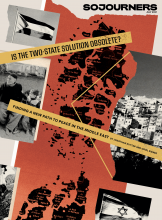JONATHAN KUTTAB’S Is the Two-State Solution Obsolete? is an important, clear-eyed contribution to the conversation about the future of Israel-Palestine. Kuttab directly and with a forgiving spirit addresses what is at stake, making clear why thinking beyond the two-state solution paradigm is necessary for anyone who seeks a just and equitable path forward in the region.
As he writes, the “facts on the ground” are such that the geography of the two-state solution is untenable. He primarily discusses the emotional and social toll of uprooting the settlement enterprise, which is made up of more than 700,000 Jewish settlers living scattered across the West Bank. Israel has been building the infrastructure of a one-state reality for decades now, infrastructure that advances de facto annexation, suburbanizing settlements in the Jewish imagination, and fragmenting huge swaths of Palestinian territory. Jewish Jerusalem and its settlements, roadways, and municipal systems sprawl into the boundaries of Ramallah, Bethlehem, the Jordan Valley, and Palestinian East Jerusalem.
Currently, Israel is working on highway, housing, and water projects that are literally destroying and tunneling through mountains—and communities—in the landscape around Jerusalem and throughout the West Bank. This is not to mention the unending settler encroachment—in the past month alone, there have been four new settler outpost projects just in the South Hebron Hills. These steps are not easily undone, and with each construction project, Israel’s pseudo “two-state commitment” becomes more and more deeply embedded in an oppressive and unequal one-state reality.
Read the Full Article

